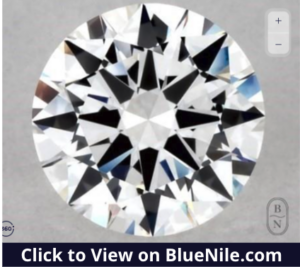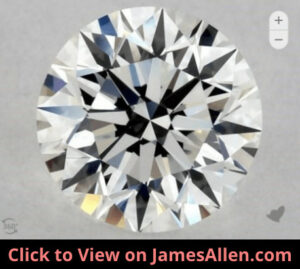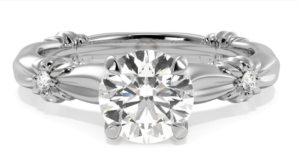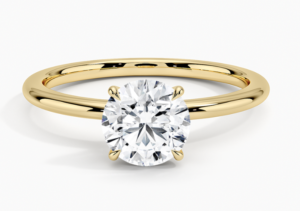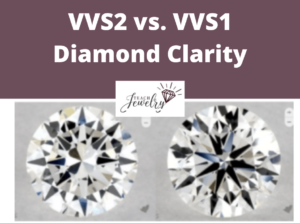
The clarity grade of a diamond is based on inclusions. Flaws appear on the inside of a diamond and affect its appearance, brilliance, and durability.
“VVS” stands for “very very slightly included” and is one step below “internally flawless” on the clarity scale. Within the VVS grade, there are two levels: VVS2 and VVS1.
The main difference between VVS2 and VVS1 diamond clarity is VVS2 diamonds have slightly more impactful inclusions that are easier to identify under magnification. VVS1 diamonds are nearly flawless but still have minor instances of flaws like pinpoints or naturals.
Let’s compare VVS2 versus VVS1 diamonds, including an overview of each, differences, similarities, and how to decide which is right for you.
What is VVS2 Diamond Clarity?
VVS2 diamond clarity is one grade below VVS1 and one above VS1 (very slightly included).
When gemologists examine inclusions, they use 10x magnification and pour over the diamond with a loupe.
A VVS2 grade means the inclusions were barely visible at this magnification.
Check out this high-resolution image of a VVS2 clarity diamond from James Allen, where I bought my wife’s engagement ring.
Notice how it appears clean even in high-resolution.
There aren’t specific types of inclusions, such as twinning wisps, cavities, or clouds, that warrant a VVS2 clarity grade.
Instead, it’s based on the visibility, position, and impact of the inclusions.
It could be a small, transparent feather on the table, a few black spots, or pinpoints scattered in different places on its surface.
For example, this 0.99-carat diamond earned a VVS2 clarity grade from the Gemological Institute of America (GIA).
The GIA report shows the following flaws:
- Cloud
- Feather
- Indented natural
- Natural
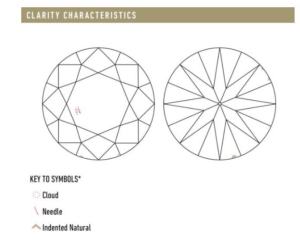
Under the “Key to Symbols” section, blemishes are ordered by their degree of impact.
The comments on the report also indicate surface graining and internal graining.
The common thread to the inclusions in a VVS2 diamond is they often can’t be seen with the naked eye and have a minimal effect on its overall performance.
What is VVS1 Diamond Clarity?
VVS1 diamonds have inclusions only visible with 10x magnification. They’re often the types that have the least effect on a diamond, such as pinpoints, feathers, and naturals.
This one-carat diamond was designated VVS1 by the GIA because of its tiny pinpoint and indented natural.
If you rotate the image 360 degrees on the vendor’s site, you still can’t find its flaws.
The feather is so small it’s barely visible on the inclusions plot, and the same is true of the pinpoints.
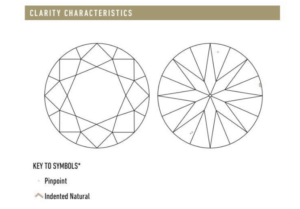
But because these flaws were visible with a jewelry loupe, it couldn’t earn an internally flawless grade.
It’s rare to find a VVS1 diamond with more than three types of inclusions, even if they’re small.
VVS1 is one grade below internally flawless.
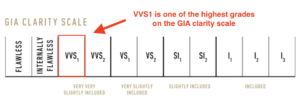
To earn that grade, a diamond must have no visible inclusions at 10x magnification.
It may have imperfections on its surface.
To the naked eye, a VVS1 diamond will look equivalent to a VVS2 or flawless one.
When you twirl it around, the inclusions won’t block light from entering the diamond or cause it to reflect out of the diamond in a way that diminishes its brilliance.
How are VVS2 and VVS1 Clarity Different?
1. VVS2 Diamonds Have More Inclusions
In most cases, VVS2 diamonds will have a higher number of inclusions compared to VVS1.
As you move down the clarity scale, from flawless to I3 diamonds, a higher number of inclusions begin to have a more noticeable impact.
While most VVS1 diamonds have one or two types of inclusions, it’s not unusual for VVS2 diamonds to feature three to five distinct flaws.
This 0.90-carat diamond received a VVS2 grade from the GIA.
The report below notes the discovery of feathers, naturals, and pinpoints.
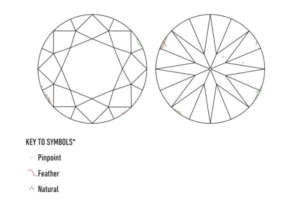
As a comparison, I’ve seen diamonds with VVS1 clarity grades that have only pinpoints.
When a diamond weighs less than one carat, the GIA report often doesn’t include the clarity characteristic plot, so check out the notes in the left panel.
VVS1 diamonds could have just one inclusion that kept it from earning an internally flawless grade, while the latter often has several types that each have a minimal impact on the diamond’s quality.
2. VVS1 Diamonds Sell for a Higher Price
Buyers are willing to pay a higher price for VVS1 diamonds because inclusions negatively impact its durability, brilliance, and aesthetic.
On one end of the spectrum, flawless diamonds have no distracting flaws, while the ones in included diamonds have potential to significantly lower its value.
The best way to understand the impact of inclusions on the price of a diamond is to compare ones with different clarity grades that are equivalent in all other areas.
I analyzed prices for several dozen round cut diamonds from James Allen with the following qualities:
- Carat weight: 0.90
- Color: G
- Cut: Very good
Some had a VVS1 clarity grade, and others were VVS2.
The average price of a VVS1 diamond was $6,025, with a range of $4,810-$6,650.
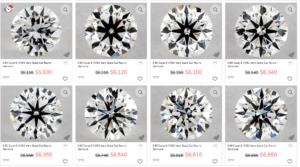
For VVS2 diamonds, the average was $5,243. The range was $4,580-$5,990.
That’s a 15 percent premium for a VVS1 versus VVS2 diamond.
You can save on the price of your diamond by opting for a VVS1 diamond.
To the naked eye, you can’t tell the difference between the two, but you could put that savings toward a quality setting or higher grade across another one of the four Cs.
3. Locations of Inclusions
Gemologists don’t only take into account the size and type of inclusions when assigning VVS1 or VVS2 clarity.
Location also makes a difference.
As an example, inclusions near the diamond’s girdle could leave it susceptible to chipping, especially if it’s an extremely thin girdle. It often results in a lower clarity grade.
I’ve highlighted the girdle in the image below for reference.
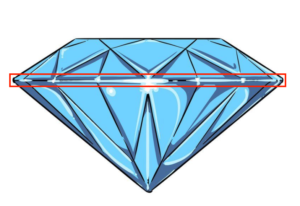
Similarly, inclusions on its table often diminish its value more than ones on its pavilion or off center.
If the gemologist views the diamond from the bottom up and sees small inclusions, they may give it a VVS1 grade.
On the other hand, inclusions visible at 10x magnification from a face up, table down view may result in a VVS2 clarity grade.
The reason is it has potential to inhibit light performance because light would first hit facets on the table. Inclusions on the pavilion or near the culet are unlikely to have this effect.
View the relative location of inclusions on the GIA report and determine whether they’re visible from the top down or bottom up.
On the clarity plot, the image on the left is of the top. The one on the right is from the pavilion.
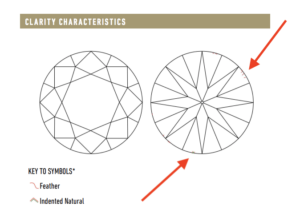
It’s another factor to consider in deciding how inclusions affect a VVS1 and VVS2 clarity diamond.
4. VVS1 Diamonds Exhibit More Brilliance
Inclusions affect the brilliance of a diamond because they distort how light enters and exits.
In a flawless diamond with a quality cut, light can freely enter and pass through a diamond, returning fire and brilliance to the viewer.
In the example of an engagement ring below, its VVS2 clarity grade means inclusions will have minimal impact on brilliance, but its very good cut grade causes it to appear dull compared to an ideal one.
If light hits a bruise, cavity, or twinning wisp inclusion, it may not return to the viewer in the same way.
That’s why VVS1 diamonds are more brilliant than VVS2 diamonds, if all other qualities are equal. But the difference is often not apparent to the naked eye.
Ones like pinpoints are often negligible, so I recommend focusing more on cut than clarity when it comes to brilliance.
What are the Similarities?
Both are Often Eye-Clean
The first similarity is both are considered eye-clean, which is paramount when buying a diamond.
Most buyers aren’t concerned about what it looks like under a loupe. Instead, the priority is it looks flawless when viewed with the naked eye.
VVS1 and VVS2 clarity diamonds almost always satisfy this criteria.
It’s difficult to identify the differences, even with high-resolutions photos.
Exceptions are for diamonds heavier than two carats. Their large surface areas may cause the inclusions to appear visible.
That’s why I recommend viewing it in person or through high-quality images.
Popular as Center Diamonds
Another similarity is both are often used as the center diamond in an engagement ring as opposed to accents lining the shank or complementing the main diamond.
Here’s an example of an engagement ring with a VVS2 diamond at its center.
Prioritize the cleanliness of the center diamond because it commands the most attention.
You don’t want a large black spot, a deep cavity, or dark bruise prominent on the main gem.
It should be noted that many SI1 and VS1 diamonds achieve this quality, but buyers sometimes choose VVS2 or VVS1 for a cleaner look.
Should You Choose a VVS2 or VVS1 Diamond?
If you’re deciding between a VVS2 or VVS1 diamond, you now understand their key differences and similarities. Here’s a summary of guidelines.
Consider a VVS2 diamond if:
- You aren’t concerned about small inclusions on the table or near the girdle
- You want a diamond that’s eye-clean but could have several types of inclusions
- You’re willing to pay a premium compared to eye-clean diamonds lower on the GIA clarity scale but still want to save relative to VVS1 or higher
Choose VVS1 if:
- You want a diamond that appears flawless, but isn’t as expensive as one with that grade
- It’s important inclusions aren’t in positions that could affect its light performance or durability
By comparing VVS2 and VVS1 diamonds and pairing them with different styles of settings, you’ll find the perfect fit for you.
Q&A Section on VVS2 vs VVS1 Diamond Clarity
Q1: How does the clarity of VVS diamonds affect their rarity and value compared to other grades? A1: VVS diamonds, including both VVS2 and VVS1, are significantly rarer than lower clarity grades like SI (Slightly Included) or I (Included) diamonds. Their rarity contributes to their higher value. VVS1 diamonds, being of a higher clarity grade than VVS2, are rarer and thus more valuable. The difference in value between VVS1 and VVS2 is often reflected in the price, with VVS1 diamonds commanding a premium.
Q2: In what scenarios might a gemologist downgrade a diamond from VVS1 to VVS2 solely based on the location of inclusions? A2: A gemologist might downgrade a diamond from VVS1 to VVS2 if the inclusions are located in more visible areas, such as directly under the table of the diamond. This location can potentially impact the stone’s light performance more than inclusions located on the sides or near the girdle. Therefore, even if the inclusions are very slight, their placement can affect the clarity grade.
Q3: Are there specific settings or cuts of diamonds where the difference between VVS1 and VVS2 clarity might be more noticeable to the naked eye? A3: In general, the differences between VVS1 and VVS2 are not visible to the naked eye. However, in certain cuts with larger tables, such as emerald or asscher cuts, inclusions might be more noticeable due to the cut’s open table and step facets. Even then, for VVS1 and VVS2 diamonds, the differences are subtle and typically require magnification to detect.
Q4: Can the presence of certain types of inclusions, like clouds or feathers, influence whether a diamond is graded as VVS1 or VVS2? A4: Yes, the type of inclusions can influence the grading. Feathers, which are small cracks inside the diamond, may be less significant if they are extremely thin or located at the periphery. Clouds, which are clusters of pinpoints, could impact the grade more if they are dense enough to affect transparency. The visibility and impact of these inclusions under 10x magnification help determine whether a diamond is classified as VVS1 or VVS2.
Q5: Is there a noticeable difference in the durability of VVS1 vs VVS2 diamonds due to the nature and placement of inclusions? A5: Both VVS1 and VVS2 diamonds are considered to have excellent durability because the inclusions are very slight and do not generally weaken the diamond’s structure. However, if a VVS2 diamond has an inclusion near the girdle or on the surface, it might theoretically be slightly less durable than a VVS1 diamond with more centrally located or internal inclusions. In practice, this difference in durability is minimal and usually not a concern for consumers.
Q6: What impact do VVS2 and VVS1 clarity grades have on the resale value of a diamond? A6: VVS2 and VVS1 diamonds retain high resale values due to their high clarity grades. However, because VVS1 diamonds are rarer and closer to internally flawless, they may hold their value slightly better than VVS2 diamonds. The exact impact on resale value also depends on other factors such as cut, color, carat weight, and market demand at the time of resale.
Q7: For diamonds of the same carat weight, how does the clarity impact the choice of a setting? A7: For high clarity diamonds such as VVS2 and VVS1, the setting choice is less about protecting the diamond from damage (as it would be with lower clarity stones that have more significant inclusions) and more about personal style preference. Since inclusions are not visible to the naked eye, settings can be chosen that best enhance the diamond’s appearance without the need to hide imperfections.
Q8: How does the grading process ensure consistency between VVS2 and VVS1 grades when assessing inclusions? A8: Grading consistency is maintained through the use of standardized procedures and guidelines established by gemological institutions like the GIA. Gemologists are trained to assess inclusions based on their size, number, location, and impact on the stone’s appearance under 10x magnification. The grading process involves multiple gemologists examining the diamond to ensure an objective and consistent grade is assigned.

Jacob Clarke
Jacob Clarke is the founder of TeachJewelry.com.
He earned an Applied Jewelry Professional Diploma from the Gemological Institute of America (GIA) and now brings you essential information about diamonds, settings, and more.
Jacob has consulted with leading jewelry brands, and his work has been cited in Clean Origin, Diamond Nexus and industry publications.
He's also a member of the International Gem Society.
He enjoys discussing jewelry with readers, so contact him with any questions at jacob.clarke@teachjewelry.com.

